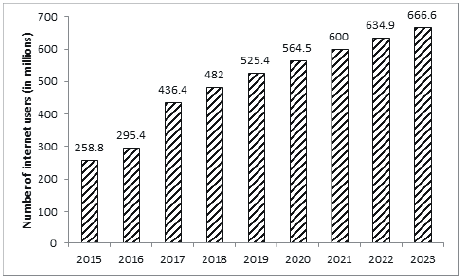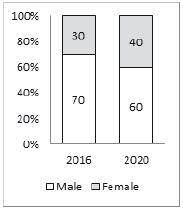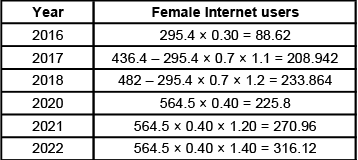CLAT Exam > CLAT Questions > The bar graph given below shows the number o...
Start Learning for Free
The bar graph given below shows the number of internet users in India from 2015 to 2019 as well as the projected number of internet users every year till 2023.

The second bar graph shows the percentage distribution of internet users in India in 2016 and estimated distribution for the year 2020 by gender.

Q. If male internet users increase by 10% and 20% in 2017 and 2018 respectively as compared to year 2016 and if female internet users are expected to increase by 20% and 40% in year 2021 and 2022 respectively as compared to year 2020, then, which of the following sequence is correct order of years in increasing order of female internet users?
- a)2016, 2018, 2017, 2020, 2021, 2022
- b)2016, 2017, 2018, 2020, 2021, 2022
- c)2016, 2017, 2020, 2018, 2021, 2022
- d)2016, 2018, 2017, 2020, 2022, 2021
Correct answer is option 'C'. Can you explain this answer?
Verified Answer
The bar graph given below shows the number of internet users in India...

Hence, required order is 2016 > 2017 > 2020 > 2018 > 2021 > 2022.

|
Explore Courses for CLAT exam
|

|
Similar CLAT Doubts
The bar graph given below shows the number of internet users in India from 2015 to 2019 as well as the projected number of internet users every year till 2023.The second bar graph shows the percentage distribution of internet users in India in 2016 and estimated distribution for the year 2020 by gender.Q. If male internet users increase by 10% and 20% in 2017 and 2018 respectively as compared to year 2016 and if female internet users are expected to increase by 20% and 40% in year 2021 and 2022 respectively as compared to year 2020, then, which of the following sequence is correct order of years in increasing order of female internet users?a)2016, 2018, 2017, 2020, 2021, 2022b)2016, 2017, 2018, 2020, 2021, 2022c)2016, 2017, 2020, 2018, 2021, 2022d)2016, 2018, 2017, 2020, 2022, 2021Correct answer is option 'C'. Can you explain this answer?
Question Description
The bar graph given below shows the number of internet users in India from 2015 to 2019 as well as the projected number of internet users every year till 2023.The second bar graph shows the percentage distribution of internet users in India in 2016 and estimated distribution for the year 2020 by gender.Q. If male internet users increase by 10% and 20% in 2017 and 2018 respectively as compared to year 2016 and if female internet users are expected to increase by 20% and 40% in year 2021 and 2022 respectively as compared to year 2020, then, which of the following sequence is correct order of years in increasing order of female internet users?a)2016, 2018, 2017, 2020, 2021, 2022b)2016, 2017, 2018, 2020, 2021, 2022c)2016, 2017, 2020, 2018, 2021, 2022d)2016, 2018, 2017, 2020, 2022, 2021Correct answer is option 'C'. Can you explain this answer? for CLAT 2025 is part of CLAT preparation. The Question and answers have been prepared according to the CLAT exam syllabus. Information about The bar graph given below shows the number of internet users in India from 2015 to 2019 as well as the projected number of internet users every year till 2023.The second bar graph shows the percentage distribution of internet users in India in 2016 and estimated distribution for the year 2020 by gender.Q. If male internet users increase by 10% and 20% in 2017 and 2018 respectively as compared to year 2016 and if female internet users are expected to increase by 20% and 40% in year 2021 and 2022 respectively as compared to year 2020, then, which of the following sequence is correct order of years in increasing order of female internet users?a)2016, 2018, 2017, 2020, 2021, 2022b)2016, 2017, 2018, 2020, 2021, 2022c)2016, 2017, 2020, 2018, 2021, 2022d)2016, 2018, 2017, 2020, 2022, 2021Correct answer is option 'C'. Can you explain this answer? covers all topics & solutions for CLAT 2025 Exam. Find important definitions, questions, meanings, examples, exercises and tests below for The bar graph given below shows the number of internet users in India from 2015 to 2019 as well as the projected number of internet users every year till 2023.The second bar graph shows the percentage distribution of internet users in India in 2016 and estimated distribution for the year 2020 by gender.Q. If male internet users increase by 10% and 20% in 2017 and 2018 respectively as compared to year 2016 and if female internet users are expected to increase by 20% and 40% in year 2021 and 2022 respectively as compared to year 2020, then, which of the following sequence is correct order of years in increasing order of female internet users?a)2016, 2018, 2017, 2020, 2021, 2022b)2016, 2017, 2018, 2020, 2021, 2022c)2016, 2017, 2020, 2018, 2021, 2022d)2016, 2018, 2017, 2020, 2022, 2021Correct answer is option 'C'. Can you explain this answer?.
The bar graph given below shows the number of internet users in India from 2015 to 2019 as well as the projected number of internet users every year till 2023.The second bar graph shows the percentage distribution of internet users in India in 2016 and estimated distribution for the year 2020 by gender.Q. If male internet users increase by 10% and 20% in 2017 and 2018 respectively as compared to year 2016 and if female internet users are expected to increase by 20% and 40% in year 2021 and 2022 respectively as compared to year 2020, then, which of the following sequence is correct order of years in increasing order of female internet users?a)2016, 2018, 2017, 2020, 2021, 2022b)2016, 2017, 2018, 2020, 2021, 2022c)2016, 2017, 2020, 2018, 2021, 2022d)2016, 2018, 2017, 2020, 2022, 2021Correct answer is option 'C'. Can you explain this answer? for CLAT 2025 is part of CLAT preparation. The Question and answers have been prepared according to the CLAT exam syllabus. Information about The bar graph given below shows the number of internet users in India from 2015 to 2019 as well as the projected number of internet users every year till 2023.The second bar graph shows the percentage distribution of internet users in India in 2016 and estimated distribution for the year 2020 by gender.Q. If male internet users increase by 10% and 20% in 2017 and 2018 respectively as compared to year 2016 and if female internet users are expected to increase by 20% and 40% in year 2021 and 2022 respectively as compared to year 2020, then, which of the following sequence is correct order of years in increasing order of female internet users?a)2016, 2018, 2017, 2020, 2021, 2022b)2016, 2017, 2018, 2020, 2021, 2022c)2016, 2017, 2020, 2018, 2021, 2022d)2016, 2018, 2017, 2020, 2022, 2021Correct answer is option 'C'. Can you explain this answer? covers all topics & solutions for CLAT 2025 Exam. Find important definitions, questions, meanings, examples, exercises and tests below for The bar graph given below shows the number of internet users in India from 2015 to 2019 as well as the projected number of internet users every year till 2023.The second bar graph shows the percentage distribution of internet users in India in 2016 and estimated distribution for the year 2020 by gender.Q. If male internet users increase by 10% and 20% in 2017 and 2018 respectively as compared to year 2016 and if female internet users are expected to increase by 20% and 40% in year 2021 and 2022 respectively as compared to year 2020, then, which of the following sequence is correct order of years in increasing order of female internet users?a)2016, 2018, 2017, 2020, 2021, 2022b)2016, 2017, 2018, 2020, 2021, 2022c)2016, 2017, 2020, 2018, 2021, 2022d)2016, 2018, 2017, 2020, 2022, 2021Correct answer is option 'C'. Can you explain this answer?.
Solutions for The bar graph given below shows the number of internet users in India from 2015 to 2019 as well as the projected number of internet users every year till 2023.The second bar graph shows the percentage distribution of internet users in India in 2016 and estimated distribution for the year 2020 by gender.Q. If male internet users increase by 10% and 20% in 2017 and 2018 respectively as compared to year 2016 and if female internet users are expected to increase by 20% and 40% in year 2021 and 2022 respectively as compared to year 2020, then, which of the following sequence is correct order of years in increasing order of female internet users?a)2016, 2018, 2017, 2020, 2021, 2022b)2016, 2017, 2018, 2020, 2021, 2022c)2016, 2017, 2020, 2018, 2021, 2022d)2016, 2018, 2017, 2020, 2022, 2021Correct answer is option 'C'. Can you explain this answer? in English & in Hindi are available as part of our courses for CLAT.
Download more important topics, notes, lectures and mock test series for CLAT Exam by signing up for free.
Here you can find the meaning of The bar graph given below shows the number of internet users in India from 2015 to 2019 as well as the projected number of internet users every year till 2023.The second bar graph shows the percentage distribution of internet users in India in 2016 and estimated distribution for the year 2020 by gender.Q. If male internet users increase by 10% and 20% in 2017 and 2018 respectively as compared to year 2016 and if female internet users are expected to increase by 20% and 40% in year 2021 and 2022 respectively as compared to year 2020, then, which of the following sequence is correct order of years in increasing order of female internet users?a)2016, 2018, 2017, 2020, 2021, 2022b)2016, 2017, 2018, 2020, 2021, 2022c)2016, 2017, 2020, 2018, 2021, 2022d)2016, 2018, 2017, 2020, 2022, 2021Correct answer is option 'C'. Can you explain this answer? defined & explained in the simplest way possible. Besides giving the explanation of
The bar graph given below shows the number of internet users in India from 2015 to 2019 as well as the projected number of internet users every year till 2023.The second bar graph shows the percentage distribution of internet users in India in 2016 and estimated distribution for the year 2020 by gender.Q. If male internet users increase by 10% and 20% in 2017 and 2018 respectively as compared to year 2016 and if female internet users are expected to increase by 20% and 40% in year 2021 and 2022 respectively as compared to year 2020, then, which of the following sequence is correct order of years in increasing order of female internet users?a)2016, 2018, 2017, 2020, 2021, 2022b)2016, 2017, 2018, 2020, 2021, 2022c)2016, 2017, 2020, 2018, 2021, 2022d)2016, 2018, 2017, 2020, 2022, 2021Correct answer is option 'C'. Can you explain this answer?, a detailed solution for The bar graph given below shows the number of internet users in India from 2015 to 2019 as well as the projected number of internet users every year till 2023.The second bar graph shows the percentage distribution of internet users in India in 2016 and estimated distribution for the year 2020 by gender.Q. If male internet users increase by 10% and 20% in 2017 and 2018 respectively as compared to year 2016 and if female internet users are expected to increase by 20% and 40% in year 2021 and 2022 respectively as compared to year 2020, then, which of the following sequence is correct order of years in increasing order of female internet users?a)2016, 2018, 2017, 2020, 2021, 2022b)2016, 2017, 2018, 2020, 2021, 2022c)2016, 2017, 2020, 2018, 2021, 2022d)2016, 2018, 2017, 2020, 2022, 2021Correct answer is option 'C'. Can you explain this answer? has been provided alongside types of The bar graph given below shows the number of internet users in India from 2015 to 2019 as well as the projected number of internet users every year till 2023.The second bar graph shows the percentage distribution of internet users in India in 2016 and estimated distribution for the year 2020 by gender.Q. If male internet users increase by 10% and 20% in 2017 and 2018 respectively as compared to year 2016 and if female internet users are expected to increase by 20% and 40% in year 2021 and 2022 respectively as compared to year 2020, then, which of the following sequence is correct order of years in increasing order of female internet users?a)2016, 2018, 2017, 2020, 2021, 2022b)2016, 2017, 2018, 2020, 2021, 2022c)2016, 2017, 2020, 2018, 2021, 2022d)2016, 2018, 2017, 2020, 2022, 2021Correct answer is option 'C'. Can you explain this answer? theory, EduRev gives you an
ample number of questions to practice The bar graph given below shows the number of internet users in India from 2015 to 2019 as well as the projected number of internet users every year till 2023.The second bar graph shows the percentage distribution of internet users in India in 2016 and estimated distribution for the year 2020 by gender.Q. If male internet users increase by 10% and 20% in 2017 and 2018 respectively as compared to year 2016 and if female internet users are expected to increase by 20% and 40% in year 2021 and 2022 respectively as compared to year 2020, then, which of the following sequence is correct order of years in increasing order of female internet users?a)2016, 2018, 2017, 2020, 2021, 2022b)2016, 2017, 2018, 2020, 2021, 2022c)2016, 2017, 2020, 2018, 2021, 2022d)2016, 2018, 2017, 2020, 2022, 2021Correct answer is option 'C'. Can you explain this answer? tests, examples and also practice CLAT tests.

|
Explore Courses for CLAT exam
|

|
Signup for Free!
Signup to see your scores go up within 7 days! Learn & Practice with 1000+ FREE Notes, Videos & Tests.
























